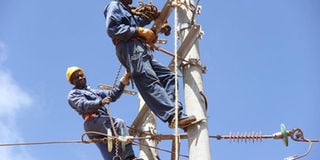Kenya Power’s shift to concrete poles leaves tree growers in limbo

Workers fix power transmission poles. By the end of next year, 50 per cent of all transmission poles will be concrete. FILE PHOTO | NATION MEDIA GROUP
What you need to know:
- The annual demand for wooden poles from Kenya Power has dropped from over 500,000 in 2011.
- Many farmers and organisations that had heavily invested in the growing of eucalyptus trees are now in a market dilemma for their mature trees.
Anxiety has gripped growers of trees used for electricity transmission poles following a decision by Kenya Power and the Rural Electrification Authority to shift to concrete ones.
Kenya Power intends to use concrete poles for all new transmission lines, limiting wooden ones for domestic connections only.
By the end of next year, 50 per cent of all transmission poles will be concrete.
The annual demand for wooden poles from Kenya Power has dropped from over 500,000 in 2011, when the shift started, to the current 200,000, according to the Kenya Wood Preservers Association (KWPA).
The shift has had a devastating impact not only on commercial tree growers but also manufacturers and suppliers of wooden poles.
At least four wood processing factories with 200 employees closed shop due to lack of a market for wooden electricity poles.
According to KWPA Chairman George Ali, operations of the remaining 36 are in limbo.
Many farmers and organisations that had heavily invested in the growing of eucalyptus trees are now in a market dilemma for their mature trees.
The more than 12,000 members of the Kenya Forest Growers Association (Kefga) have, for example, so far used Sh1.2 billion to establish 10,000-hectare eucalyptus plantations.
The Miti Mingi project has over 1 million mature eucalyptus trees that are ready for harvesting but there is no market for poles.
Eucalyptus trees grown for electricity poles take seven to 10 years to mature, depending on the climate, topography and soil conditions of the area.
It is difficult to understand why Kenya Power and REA have decided to spend more on concrete poles when there is a much cheaper and proven alternative.
First, concrete poles are 40 per cent more expensive than wooden ones. Prices range between Sh18,000 and Sh20,000 for a concrete pole against Sh10,000 to Sh12,000 for a treated wooden one.
COMPARISON
While Kenya Power argues that wooden posts have a shorter lifespan and are, therefore, more expensive over time, Mr Ali thinks otherwise.
The lifespan of a well-done concrete pole is 50 years while that of a well-treated wooden one is 40.
“The difference in costs and lifespan does not make wooden poles expensive. Concrete poles still remain expensive,” said Mr Ali.
Tree Biotechnology Programme Executive Director Benson Kanyi notes that the benefits of using wooden poles go beyond just financial gains.
“In an era where every government and institution are very much concerned about climate change and how to mitigate the potential impacts on the environment and life, the sensible thing is to encourage a green economy,” he said.
Dr Kanyi takes issue with the shift to concrete poles, saying it is against the government’s own commitment towards a green economy that is aimed at reducing environmental risks and ecological hazards, one that is bent on ensuring sustainable development without degrading the environment.
While agreeing that concrete poles have some advantages in certain situations, the world over, wooden power transmission poles are preferred to concrete ones due to handling and environmental compliance.
This calls for a policy statement that stipulates a quota for each and circumstances on the advantages so that both commercial tree growers and concrete poles producers can project their investments accordingly.
METALLIC POLES
Jungle Energy (K) Ltd, which is based in Thika, and the Chinese-owned Beijing Electric Power Transmission and Transformation Company, situated on Mombasa Road in Nairobi, are the manufacturers of concrete poles.
In Tanzania, the government plans to restrict the use of concrete poles to areas prone to bush fires and those that are wet or swampy, where wooden ones cannot withstand the conditions, according to Tanzania Electric Supply Company.
This is also the case in the United States, where concrete or metallic poles are used to replace old wooden ones in areas with severe weather conditions.
Uganda is still using wooden poles but plans to use metallic ones for high voltage transmission only.
The Uganda Electricity Transmission Company Limited said a case in point is the conversion of the wooden 300-kilometre Tororo to Lira line to metal.




